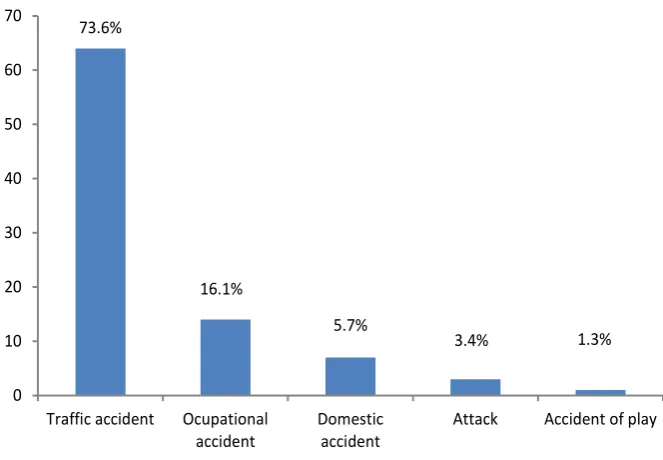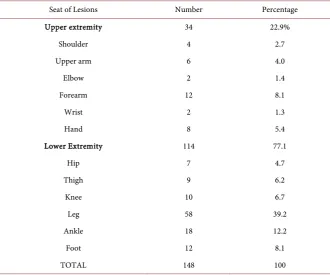http://www.scirp.org/journal/ojo ISSN Online: 2164-3016
ISSN Print: 2164-3008
DOI: 10.4236/ojo.2017.711036 Nov. 9, 2017 356 Open Journal of Orthopedics
Epidemiology of Open Limb
Fractures in a Country
with Low-Income
Noufanangue Kanfitine Kombate
1, Atchi Walla
2, Kolima Akloa
2, Komi Amakoutou
2,
Batarabadja Bakriga
2, Gamal Ayouba
2, Yaovi Yannick Dellanh
2, Anani Abalo
2,
Assang Michel Dossim
21Department of Orthopaedic and Traumatology Surgery, Saint-Jean de Dieu d’Afagnan Hospital, Lomé, Togo
2Department of Orthopaedic and Traumatology Surgery, Sylvanus Olympio Teaching Hospital, University of Lomé, Lomé, Togo
Abstract
Introduction: Open limb fractures are frequent and severe. Very often they result from high velocity traffic accidents. The aim of this study was to iden-tify the epidemiologic aspects of open limb fractures in order to improve pre-vention and care. Material and Methods: It was a retrospective study carried out in the Department of Orthopaedic and traumatology Surgery of Afagnan hospital. It concerned the files of patients admitted from January 1st to De-cember 31st 2016. Patients of 15 years old and older who presented open limb fractures were included in the study. The study variables were: age, sex, occu-pation, trauma aetiology, injury mechanism, location and type of lesions. An X-ray (antero-posterior and lateral view) of the injured limb segment was done in all patients. Results: On 87 patients, 148 cases of fractures were col-lected. The mean age was 38.08 years with extremes of 15 and 82. There were 23 women (26.4%) and 64 men (73.6%). The most common etiology was traf-fic accidents (73.5%). Motorcycle accidents (58.3%); accidents involving mo-torcycle and car (19.4%). Accidents at work represented (16.1%). Lower limbs were more affected (77.1%). Open fractures classified Gustillo-Anderson type III were predominant with type IIIa (51.0%), IIIb (32.6%) and IIIc (16.3%). Conclusion: Open limb fractures are severe. They are mainly due to the in-crease of high-velocity traffic accidents. This explains the predominance of the young male population. Road safety and all actors’ behaviour change are es-sential for the reduction of traffic accident morbidity.
Keywords
Open Fracture, Limb, Epidemiology How to cite this paper: Kombate, N.K.,
Walla, A., Akloa, K., Amakoutou, K., Bakri-ga, B., Ayouba, G., Dellanh, Y.Y., Abalo, A. and Dossim, A.M. (2017) Epidemiology of Open Limb Fractures in a Country with Low-Income. Open Journal of Orthopedics, 7, 356-361.
https://doi.org/10.4236/ojo.2017.711036
Received: September 26, 2017 Accepted: November 6, 2017 Published: November 9, 2017
Copyright © 2017 by authors and Scientific Research Publishing Inc. This work is licensed under the Creative Commons Attribution International License (CC BY 4.0).
DOI: 10.4236/ojo.2017.711036 357 Open Journal of Orthopedics
1. Introduction
The open fractures of the extremities are very frequent, remain a real challenge for the surgeons and cause a significant morbidity [1]. They are caused for more the share of time by the accidents of interstate at the time of the high-energy traumas. The latter are in constant increase, because of increase in the car fleet and the proliferation of the machines at very high speeds. They engage some-times the vital prognosis of traumatized and when they are not deadly, they in-volve heavy impairments which often pose problems of socio-professional rein-tegration of the patients thus constituting true public health problems [2] [3] [4]. Apart from the fracture, the skin lesions muscles, vascular nervous and sinewy are frequently associated making complex the treatment [3]. This treatment must be codified well starting on the place of the accident and integrating a mul-tidisciplinary team [5], namely: the emergency medical treatment which is gen-erally put at contribution in the first hours, the physical therapy and of read-justment which deals with the physical therapy in order to limit the squealers, the general medicine which ensures the long-term follow-up and also the occu-pational medicine because most of the road accidents are commuting accidents (residence-work). In the developing countries like ours, the shortage of facility and financial means complicates the treatment of the open fractures of extremi-ties. We had conducted this study in order to release the epidemiological profile, to adapt the treatment of these injuries and to formulate suggestions for an ac-cident prevention.
2. Material and Method
This study was conducted in the Department of Orthopaedic and Traumatology surgery hospital of Afagnan which was a tertiary care institute in Togo. It was about a retrospective study which enrolled the records of the patients of more than 15 years, having presented an open fracture of extremity during the period of time of January first to December 31st, 2016. This hospital receives 2482 tients by year including 482 closed fractures and 148 open fractures. All the pa-tients profited from a radiographic evaluation and the treatment of the lesion observed. The incomplete records and the records of the patients presenting the traumas other than the extremities were not included in our study. Information collected enabled us to analyse the age, the sex, the occupation, the source, the etiology of the trauma, the injury mechanism, the seat of the lesions and the type of injury observe.
3. Results
87 patients were enrolled for this study and 148 fractures were observed. The mean age was 38.08 years (15 - 82). We noted a predominance of the age bracket of 16 - 29 years (Figure 1).
DOI: 10.4236/ojo.2017.711036 358 Open Journal of Orthopedics accidents represented (16.1%) (Figure 2).
We found: fifty and one case of accident motorbike-motorbike (58.3%); 17 cases of automobile- Motorbike accident (19.4%), 9 cases of accident motorbike- pedestrian (Table 1). According To the occupation, the patients having a liberal profession were touched in 70 cases (80.4%). The lower extremity was touched the most with a frequency of 77.01% (Table 2).
[image:3.595.208.540.230.456.2]The open fractures type III of Gustilo-Anderson were predominant (56.3%): The type IIIa, standard IIIa and type IIIa accounted for 51.1% respectively; 32.6% and 16.3%. The open fractures of type II accounted for 32.2%. The lesions of the type I as for them accounted for only 11.5%.
Figure 1. Distribution of the Fractures according to the Slice of Elderly.
Figure 2. Distribution according to the etiology of the open Fractures.
43.8%
32.2%
16.2%
6.8%
0 5 10 15 20 25 30 35 40 45
16-29 years 30-49 years 45-59 years 60 years
73.6%
16.1%
5.7%
3.4% 1.3%
0 10 20 30 40 50 60 70
Traffic accident Ocupational
[image:3.595.207.539.480.710.2]DOI: 10.4236/ojo.2017.711036 359 Open Journal of Orthopedics
Table 1. Distribution according to the type of accidents.
Types of accident Number Percentage (%)
motorbike-motorbike Accident 51 58.3
Automobile Accident 17 19.5
Mobike-Piedestrian Accident 9 11.1
Auto- Piedestrian Accident 6 06.5
Cyclist Accident 4 4.6
TOTAL 87 100
Table 2. Distribution according to the seat of the lesions.
Seat of Lesions Number Percentage
Upper extremity 34 22.9%
Shoulder 4 2.7
Upper arm 6 4.0
Elbow 2 1.4
Forearm 12 8.1
Wrist 2 1.3
Hand 8 5.4
Lower Extremity 114 77.1
Hip 7 4.7
Thigh 9 6.2
Knee 10 6.7
Leg 58 39.2
Ankle 18 12.2
Foot 12 8.1
TOTAL 148 100
4. Discussion
[image:4.595.208.539.239.514.2]DOI: 10.4236/ojo.2017.711036 360 Open Journal of Orthopedics a liberal profession were mainly touched. Konan and al. also noted a predomi-nance of this professional, very active and very mobile [3]. The accidents of the public highway were at the origin of the open fractures of extremity in 73.56% of the cases. For Frederico Carlos et al., [10] the open fractures were caused by the accidents of the public highway in 84% of the cases of which 57% implied the motorcyclists. The violence of the bumps at the time of these traumas could ex-plain this raised frequency, especially when the patient is with motor bike and without any protection for the extremity. The lesions seat preferentially at the lower extremity 77.02% with a predominance with the leg (39.18%). The lesions of the types III of Gustilo prevailed in our series. In the study reported by AM
Ali et al., the lesions of the type IIIa, IIIb and IIIc accounted for 8%, 76% and
16% respectively [11]. With regard to the lesions of the type III, our results cor-respond to those of Frederico Carlos et al. [10] which also noted a predominance of type IIIa Lesions. The Types IIIa, IIIb and IIIc respectively accounted for 81%, 12% and 7%. Most of the lesions of the type III testify to the violence of the bump at the time of traumas and the Injury Severity which they generate.
5. Conclusion
The increase in road traumatology with high-energy is at the origin of the open fractures extremities generally serious. She explains the paramount place of the young topics of male sex which are followers of the high-risk hazardous activi-ties. An absolute respect of the rules of traffic control and behavioural change of all the road users will make it possible to reduce the morbidity and the mortality of these lesions.
References
[1] Yarrow, J., Rahman, S., Marsden, N., Pallister, I. and Hemington-Gorse, S. (2015) Management of Open Lower Limb Injuries in South West England and Wales. An-nals of the Royal College of Surgeons of England, 97, 35-39.
https://doi.org/10.1308/003588414X14055925058472
[2] Clelland, S.J., Chauhan, P. and Mandari, F.N. (2016) The Epidemiology and Man-agement of Tibia and Fibula Fractures at Kilimanjaro Christian Medical Centre (KCMC) in Northern Tanzania. Pan African Medical Journal, 25, 10-12.
[3] Konan, K.J., Assouan, K.T., Kouassi, F. and Ehua, S.F. (2006) Epidemiology of Traf-fic Road Injuries in Teaching University Hospital of Yopougon. International Med-ical Science Review, 8, 44-48.
[4] Court-Brown, C.M., Bugler, K.E., Clement, N.D., Duckworth, A.D. and McQueen, M.M. (2012) The Epidemiology of Open Fractures in Adults: A 15-Year Review.
Injury, 43, 891-897. https://doi.org/10.1016/j.injury.2011.12.007
[5] Nanchahal, J., Nayagam, S., Khan, U., et al. (2009) Standards for the Management of Open Fractures of the Lower Limb. BAPRAS, London.
DOI: 10.4236/ojo.2017.711036 361 Open Journal of Orthopedics
A.B. and Gilyoma, J.M. (2012) Injury Characteristics and Outcome of Road Traffic Crash Victims at Bugando Medical Centre in Northwestern Tanzania. Journal of Trauma Management and Outcomes, 6, 1. https://doi.org/10.1186/1752-2897-6-1
[8] Twagirayezu, E., Teteli, R., Bonane, A. and Rugwizangoga, E. (2008) Road Traffic Injuries at Kigali University Central Teaching Hospital, Rwanda. East and Central African Journal of Surgery, 13, 73-76.
[9] Chalya, P.L., Mabula, J.B., Ngayomela, I.H., Kanumba, E.S., Chandika, A.B., Giiti, G., Mawala, B. and Balamuka, D. (2010) Motorcycle Injuries as an Emerging Public Health Problem in Mwanza City Tanzania: A Call for Urgent Intervention. Tanza-nia Journal of Health Research, 12, 214-221. https://doi.org/10.4314/thrb.v12i4.55500
[10] Frederico Carlos, J.N., Marina de Paula, C., Bernardo Aurelio, F.A., Pablício, M.F., Efferson, C.A. and Robson, A.S. (2016) Analysis of the Characteristics of Patients with Open Tibial Fractures of Gustilo and Anderson Type III. Revista Brasileira de Ortopedia (English Edition), 51, 143-149.https://doi.org/10.1016/j.rboe.2016.01.002
[11] Ali, A.M., McMaster, J.M., Noyes, D., Brent, A.J. and Cogswell, L.K. (2015) Experi-ence of Managing Open Fractures of the Lower Limb at a Major Trauma Centre.
Annals of The Royal College of Surgeons of England, 97, 287-290.

